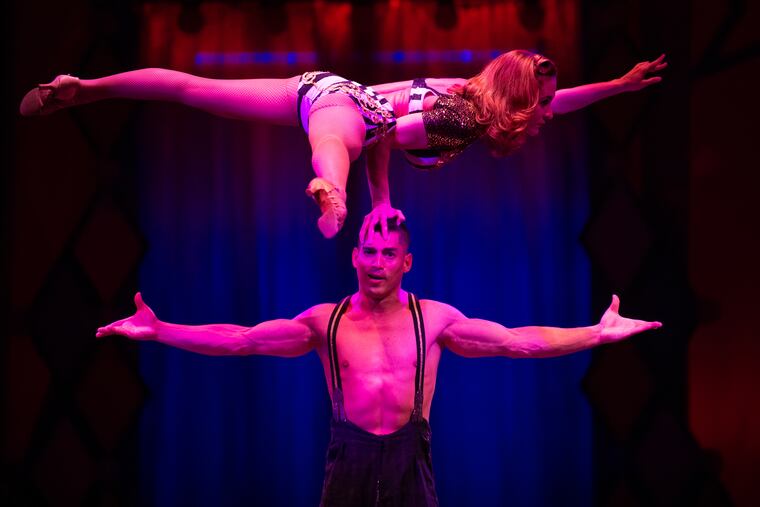A high wire act: 3 years after declaring bankruptcy, Big Apple Circus seeks a new audience
Big Apple Circus, under new leadership and a for-profit business model, hopes to attract millennials and adults through better social media and $12 craft cocktails with red Twizzler straws.

Chloe O’Donnell, 5, sat in the front row at the Big Apple Circus, her mouth agape and eyes hypnotized by the five trapeze artists soaring 10 feet above her.
This was the Ambler resident’s first time at a circus, and by the end of the show’s first half, she sounded ready to join. “I want to be a flier,” said Chloe, bouncing on an arm of her mother, Bonnie Philip. “I want to wear a pink sparkly dress and fly through the air.”
Chloe’s excitement makes her a poster child for a circus’ family-dominated attendance. But the New York-based Big Apple Circus is expanding beyond children like her, and targeting the millennial couples sitting four rows above her.
Less than three years after the company declared bankruptcy, Big Apple Circus, under new leadership and with a for-profit business model, hopes to attract millennials and adults through $12 craft cocktails with red Twizzler straws; a stronger social media presence that interacts with fans through ticket and merchandise giveaways; and more “Instagrammable” moments as seen through the tent’s vivid backdrops.
“We want to make sure that our messages are clear that all audiences are welcome," said Gregg Walker, Big Apple’s CEO since summer 2018. "And if you are a grownup, we say that your experience will be just as thrilling and just as fun, but in a different way.”
This isn’t easy when nearly the entire entertainment industry is your competition. Smart phones, movie theaters, video games, and streaming services keep people more attached to screens and less inclined to choose a circus.
Big Apple makes light of people’s screen addictions at the show’s beginning, where a clown dressed as an average Joe wanders into the ring in a cell-phone-induced trance to take a selfie. The lead clown pops up behind him, stealing his phone and making him part of the show.
“It’s difficult to convince people to part with their hard-earned money for any type of live entertainment," said Walker, who was born in Princeton and raised in Blue Bell.
Walker said the show doubled its ticket sales in New York and Washington compared with last year. But he would not provide specifics on revenues or ticket sales.
At Big Apple’s show on Wednesday at the Greater Philadelphia Expo Center in Oaks, a few hundred people of all ages were in the stands. Tickets for the run, which ends Sunday, June 16, generally cost $15 to $65.
Alex and Julie Gamler came on a double date with friends Marc and Kaitlyn Arnold because, “What else would you do on a Wednesday night?” joked Julie, 30. “We’d driven by the big blue tent every day on the way to work, and figured it would be something fun and different."
$8 million in debt, company declares bankruptcy
Big Apple Circus’s run in Philadelphia comes less than three years after the company declared bankruptcy in November 2016 after accruing more than $8 million in debt. Walker said the company, a nonprofit for much of its existence, struggled to receive enough charitable donations after the Great Recession. In February 2017, it was purchased for $1.3 million by Big Top Works, an affiliate of corporate consultant Compass Partners LLC.
Big Apple’s bankruptcy came only months before the iconic Ringling Bros. and Barnum & Bailey Circus announced its final tour after 146 years. That circus had struggled financially due to high overhead and costly legal battles with animal rights activists. (Big Apple doesn’t use exotic animals and all animals are rescues.)
Before Big Apple filed for bankruptcy, it employed 544 people, according to its 2017 tax form. Today, it employs about 100, including around 30 performers, Walker said.
While Ringling had three rings, Big Apple seeks to make a virtue out of one, because "you’re only 50 feet from the performers,” Walker said.
Circus artists face insecure job opportunities
Today, nearly 100 circus schools and training centers operate in the United States, but only about six are traditional circus companies like Big Apple, said Shana Kennedy, founding director of the Circadium School of Contemporary Circus in Germantown, which offers a three-year professional training program. There are also about six well-known smaller companies that rent venues and perform at festivals, Kennedy said.
“The circus artists who go on tour professionally right now tend to have jobs like doing gigs — corporate gigs, freelance gigs, things like that. Or they start their own solo shows," she said. "Even if they get a job with one of the big companies, it’s going to be a contract that’s maybe a half year, maybe a couple years if they’re lucky. You don’t have long-term careers with any of these companies.”
Big Apple hopes to endure. Walker said the number of people attending music festivals is increasing, proof that Americans are craving “shared, live experiences that are special.”
In the next five years, the company aims to offer a circus experience with a festival atmosphere. “Next year, you’ll start having a food experience that feels like a food festival. And then we’ll keep adding to it.”